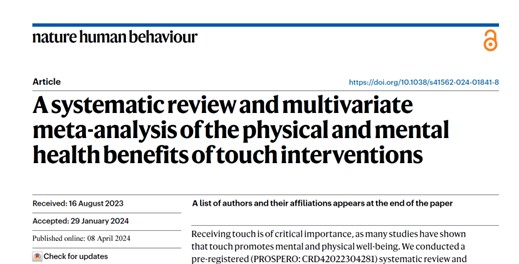I have recently been pointed to a paper focusing on ‘the physical and mental health benefits of touch interventions’ (Packheiser et al, 2024). This open-access, systematic review brings together the results of over 200 previous studies on touch interventions to arrive at its conclusions.
Now this paper is not directly concerned with the use of Intensive Interaction (it doesn’t actually mention it at all), but as socially communicative physical contact is one of the ‘Fundamentals of Communication’ (as identified by Nind & Hewett) and thus a key Intensive Interaction strategy, I feel that its findings should be of interest to us all here.
So, what are the findings and conclusions of this methodologically robust review article? Well, the study’s aim was to provide an estimate of the measurable effects of touch interventions, and also clarify which factors might be important in potentially tailoring future touch interventions more effectively.
Without going into too much detail in this Blog (you can access the full paper via the link below1) overall, variously described touch interventions (e.g. ‘massages’, ‘gentle touch’, ‘stroking’, etc) were found to be ‘beneficial for both physical and mental health, with a medium effect size’ similarly indicated across the different kinds of touch interventions. While it didn’t seem particularly important which touch intervention was applied, nor for how long, it was ‘the frequency of interventions [which] seems to matter’. Now that’s useful to know.
Interventions that used touch were clearly indicated as ‘reducing pain, depression and anxiety’ in adults and children, as well as ‘increasing weight gain’ in newborns. Indeed, the analyzed data showed the positive mental health effects of touch as being ‘mediated by the presence of skin-to-skin contact‘, across all ages.
More specifically, touch interventions were seen as effective in reducing pain, and reducing feelings of both depression and anxiety for adults and children– this correllating more strongly in terms of mental health gains for those identified with ‘clinical’ conditions as compared to ‘healthy’ individuals.
Interestingly, they found ‘no difference in health benefits in adults when comparing touch applied by a familiar person or a health care professional’, although perhaps unsurprisingly ‘parental touch was more beneficial in newborns’. Amongst lots of other variables analyzed (e.g. sex, age, location), this paper even digs down to the levels of efficacy associated with touch to various parts of the body e.g. head, arm or torso: with touch to the face or scalp (e.g. via massage) seemingly being the statistically most significant – umm, that’s interesting!
So, as we correctly say in our Intensive Interaction Institute training: ‘Touch is the first and most basic form of communication, and is essential in the development of communication abilities and for emotional well-being’. But now it is not just us saying that – increasingly scientific research is confirming the communicative and emotional significance of touch known by practitioners and advocates of Intensive Interaction for over 30 years!
As Julia Barnes points out in the ‘Intensive Interaction Classroom Guide‘, socially inclusive touch provides: feelings of reward, reinforces reciprocity, signals safety, soothes and promotes cooperation. Of course it does – we all know that. And, as Dr Dave Hewett said in his paper of 2007: Do Touch!
You can read more on the issue of touch, more specifically as related to the use of Intensive Interaction, in:
Hewett, D. (2007) ‘Do touch: physical contact and people who have severe, profound and multiple learning difficulties’, Support for Learning: https://doi.org/10.1111/j.1467-9604.2007.00458.x
Rhodes, J., & Hewett, D. (2010). ‘The human touch: Physical contact and making a social world available for the most profoundly disabled’. PMLD-Link, 22(66), 11–14.
Collett, Z., Moll, D., Colston, A., McKim, J. & Elsworth, J. (2023) ‘Expressive touch in health and social care: A review of touch guidance to explore the extent to which social and communication needs of adults with learning disabilities are considered’, British Journal of Learning Disabilities: https://doi.org/10.1111/bld.1
Full References:
- : Packheiser, J., Hartmann, H., Fredriksen, K., Gazzola, V., Keysers. C, & Michon, F. (2024) ‘A systematic review and multivariate meta-analysis of the physical and mental health benefits of touch interventions’, Nature Human Behaviour: https://doi.org/10.1038/s41562-024-01841-8.
- Barnes, J. (2022). ‘Touch: the cement that binds us’, in Mourière, A. & Smith, P. (eds) The Intensive Interaction Classroom Guide: Social Communication Learning and Curriculum for Children with Autism, Profound and Multiple Learning Difficulties, Communication Difficulties. London: Routledge.
